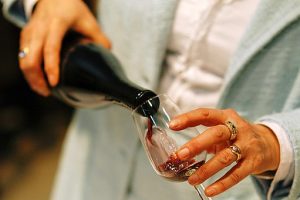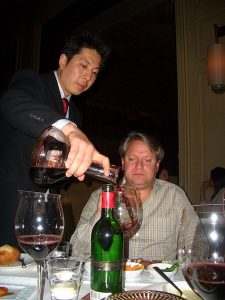Next time you are at a party, pay attention to how people pour…whether it’s from a wine bottle or from a pitcher.
I’m not talking about a “pro” at a restaurant who pours all of the time.
I’m talking about watching “normals” pour.
Here’s what you’ll normally see. Definitely not always, but normally.
- They’ll hold the pitcher in one hand and the glass in another…even if they know pouring won’t cause the glass to tip over.

- They’ll tend to hold on between the middle and the top (as opposed to the bottom)

- They’ll touch the pitcher to the glass…or get it really close.

Why is this, and how does it relate to shooting?
This is pretty cool…
So, one of the things that our brain is constantly doing is figuring out where different parts of our body are in space in relation to other parts of our body, obstacles, and things in our environment. You could call it proprioception, hand-eye coordination, or even body awareness.
In any case, the first priority is survival and threat avoidance.
A distant second is performance and taking advantage of opportunity.
The brain tends to prune unused circuits in the brain…or circuits that you haven’t emphasized as important with continual use and focus.
It will prune away performance abilities and leave you with just the bare minimum to avoid threats and survive.
If you think about pouring a glass of wine, it should be relatively straight forward to stick your thumb in the hole in the bottom of the bottle, hold it at arm’s length, and accurately pour into somebody’s glass…but for the vast majority of people, it’s not that easy…those circuits get pruned over time and we’re oftentimes left with base-level survival skills.
We use various “cheats” to make sure we don’t spill…choking up, holding both the glass and bottle at the same time in hopes that one hand can find the other, and touching the end of the bottle to the rim of the glass to minimize the chance of an error in depth perception.
I had a very challenging time with hand-eye coordination for a few years and I used dozens of “cheats” like this to compensate. And I figured out how to “upregulate” my proprioceptive system so that I don’t need to use the cheats anymore. It had a huge impact on my ability to avoid obstacles, not fall, not spill water or other drinks, and a LOT with shooting.
Touching the bottle to the rim of the glass is an interesting one for a lot of shooters.
You see, there’s an argument for reloading technique that says that you should put your support hand index finger along your magazine to increase the odds of hitting the magazine well of your pistol.
The argument being that your support hand knows exactly where your shooting hand is.
Except a lot of times it doesn’t.
I want you to try a quick drill with me.
I tried to explain it with words and finally just went out on my deck and shot this quick video.
I want you to try it with me quick…
What you’ll find is that the more you ramp up the cognitive load, the harder this “simple” drill is.
It’s easier sitting than standing.
It’s easier while silent than talking or thinking about what you’re going to say.
It’s easier when you focus on one of your fingers OR the point in space where you want them to meet.
Almost anyone can do it at slow speed, because your brain has time to auto-correct, but the faster you move, the more difficult it becomes. Of course, you already know this from past experience with aiming, reloading, and pouring.
The good news is that you can improve your hand-eye coordination by simply picking out objects in your environment and quickly touching them…ideally like you’d “pull a punch” so you do it quickly, but don’t jam your finger into light switches and other objects.
This is a pretty high-payoff skill to spend time on.
When the brain is not confident about where it is in space, it reduces the speed and intensity of motor output to your muscles…kind of like you slow down when you’re driving in a heavy rainstorm.
When it IS confident about where your body is in space, the brain will increase speed and intensity of motor output AND reduce lag time when reacting to threats and opportunities in your environment.
So…improving your hand-eye coordination (proprioception) will help with pouring drinks, aiming automatically, reloads, AND it’s also a necessity for throwing precision self-defense strikes like eye gouges, throat strikes, and groin strikes.
And, it’s one of the things that we’re going to be covering tonight (yes…we’ve got a special showing tonight!) during our Automatic Aiming training.
It’s different from Praxis & Dynamic Gunfighter and you’re going to learn how to hardwire automatic aiming into your brain that’s faster than a laser.
You’re not just going to watch me talk about it…it’s unlike any other training you’ve experienced and we’re going to do a fun assessment together to get a baseline, I’m going to run you through a couple of cool drills, and then we’re going to see just how much (and how quickly) those drills improve your automatic aiming.
This is different than any other gun training you’ve ever experienced and I can’t wait to hear how much you improve during the workshop.
You can tell it’s different from the feedback we’ve received…
From Anthony…
“Thank you very much. As usual you have incredible information and methods of teaching and training. Thank you again”
From Erin…
“Thanks so much. Excellent, professional, extremely helpful training.”
From Shayne, an early adopter of the training…
“the drills have been going quite well and the progress is noticeable. The results have been great.”
We’ll be covering automatic aiming, both-eyes-open shooting, shooting with bifocals and progressives, and much, much more.
The workshop is free for right now, but seats are limited, so click >HERE< to reserve your seat now.
Leave A Response